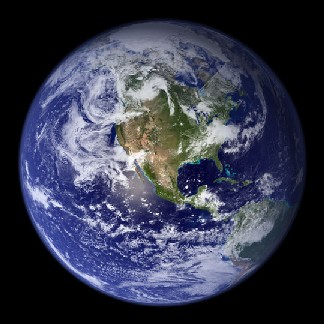United Nations
proclaims 2008 International Year of Planet
Earth
The United
Nations General Assembly, meeting in New York, has proclaimed the
year 2008 to be the United Nations International Year of Planet
Earth. The Year's activities will span the three years
2007-2009.
The International Year of Planet Earth was approved by general
acclamation of the General Assembly, and no vote was taken.
The Year's purpose, encapsulated in it strapline Earth sciences
for society, is to:

-Reduce risks for society caused by natural
and human-induced hazards
-Reduce health problems by improving understanding of the medical
aspects of Earth science
-Discover new natural resources and make them available in a
sustainable manner
-Build safer structures and expand urban areas, utilizing natural
subsurface conditions
-Determine the non-human factor in climatic change
-Enhance understanding of the occurrence of natural resources so
as to contribute to efforts to reduce political tension
-Detect deep and poorly accessible groundwater resources
-Improve understanding of the evolution of life
-Increase interest in the Earth sciences in society at large
-Encourage more young people to study Earth science in
university
The Year aims to raise $20 million from industry and governments
and will spend half on co-funding research, and half on Outreach
activities. It will be the biggest ever international effort to
promote the Earth sciences.
Apart from researchers, who are expected to benefit under the
Science Programme, the principal target groups for the Year's
broader messages are:
-Decision makers and politicians who need to be better informed
about the how Earth scientific knowledge can be used for
sustainable development.
-The voting public, which needs to know how Earth scientific
knowledge can contribute to a better society.
- Fellow geoscientists, who are very knowledgeable about various
aspects of the Earth but who need help in using their knowledge for
the benefit of the worlds population.
The research themes of the year, set out in 10 science
prospectuses were chosen for their societal relevance,
multidisciplinarity and outreach potential. The Year has 12
Founding Partners, 23 Associate Partners, and is backed politically
by 97 countries representing 87% of the worlds population. The Year
was promoted politically at UNESCO and at the United Nations in New
York by the Peoples Republic of Tanzania.
The International Year of Planet Earth has been in planning since
2001. The Year's Science Committee is chaired by Prof. Edward
Derbyshire (Royal Holloway) and its Outreach Committee by Dr Ted
Nield (Geological Society of London).
The International Year of Planet Earth project was initiated
jointly by the International Union
of Geological Sciences (IUGS) and the United Nations
Educational Scientific and Cultural Organisation (UNESCO). The UN
press release reads: "By a draft on the International Year of
Planet Earth, 2008, which the Committee approved without a vote on
11 November, the Assembly would declare 2008 the International Year
of Planet Earth. It would also designate the United Nations
Educational, Scientific and Cultural Organization (UNESCO) to
organize activities to be undertaken during the Year, in
collaboration with UNEP and other relevant United Nations bodies,
the International Union of Geological Sciences and other Earth
sciences societies and groups throughout the world. Also by that
draft, the Assembly would encourage Member States, the United
Nations system and other actors to use the Year to increase
awareness of the importance of Earth sciences in achieving
sustainable development and promoting local, national, regional and
international action".

EARTH –
third rock from the sun
Planet earth has had, as far as we can
reconstruct, a tumultuous and cataclysmic history so far. Violent
chemical reactions, outer worldly bombardment by asteroids,
terrible ignorance and bloodshed and technological breakthroughs
are but a few of the plays that have been staged on earth’s
stage.
Earth is also
the habitat of both docile and fearsome creatures; man being the
most fearsome. So why is earth a stage of contradictions? Perhaps
it has to do with the long and varied existence that it undergone
so far. Or perhaps it is our human perception of what is sweet, or
sour; peaceful, or in turmoil; forgiving, or revengeful and white,
or black.
The
planet’s history - Scientists have been able to
reconstruct detailed information about the planet's past. Earth and
the other planets in the Solar System formed
4.54 billion years ago out of the
solar nebula, a disk-shaped mass of dust
and gas left over from the formation of the Sun. Initially molten,
the outer layer of the planet Earth cooled to form a solid crust
when water began accumulating in the atmosphere. The Moon formed
soon afterwards, possibly as the result of a Mars-sized object
(sometimes called
Theia) with about 10% of the
Earth's mass impacting the Earth in a glancing blow. Some of this
object's mass would have merged with the Earth and a portion would
have been ejected into space, but enough material would have been
sent into orbit to form the Moon.
Outgassing and volcanic activity produced the primordial
atmosphere. Condensing water vapor, augmented by ice and liquid
water delivered by asteroids and the larger proto-planets, comets,
and trans-Neptunian objects produced the oceans. The highly
energetic chemistry is believed to have produced a self-replicating
molecule around 4 billion years ago, and half a billion
years later, the last common ancestor of all life existed.
The development of photosynthesis allowed the Sun's energy to be
harvested directly by life forms; the resultant oxygen accumulated
in the atmosphere and resulted in a layer of ozone (a form of
molecular oxygen [O3]) in the upper
atmosphere. The incorporation of smaller cells within larger ones
resulted in the development of complex cells called
eukaryotes. True multicellular organisms
formed as cells within colonies became increasingly specialized.
Aided by the absorption of harmful ultraviolet radiation by the
ozone layer, life colonized the surface of
Earth.
Beginning with almost no dry land, the total amount of surface
lying above the oceans has steadily increased. During the past two
billion years, for example, the total size of the continents has
doubled. As the surface continually reshaped itself, over hundreds
of millions of years, continents formed and broke up. The
continents migrated across the surface, occasionally combining to
form a supercontinent. Roughly
750 million years ago (mya), the earliest known
supercontinent, Rodinia, began to break apart. The continents
later recombined to form
Pannotia, 600–540 mya, then finally
Pangaea, which broke apart 180 mya.
Since the 1960s, it has been hypothesized that severe glacial
action between 750 and 580 mya, during the
Neoproterozoic, covered much of the
planet in a sheet of ice. This hypothesis has been termed
"Snowball Earth", and is of particular
interest because it preceded the
Cambrian explosion, when
multicellular life forms began to proliferate.
Following the Cambrian explosion, about 535 mya, there have
been five mass extinctions. The last extinction
event occurred 65 mya, when a meteorite collision probably
triggered the extinction of the (non-avian) dinosaurs and other
large reptiles, but spared small animals such as mammals, which
then resembled shrews. Over the past 65 million years,
mammalian life has diversified, and several mya, an African
ape-like animal gained the ability to stand upright.This enabled
tool use and encouraged communication that provided the nutrition
and stimulation needed for a larger brain. The development of
agriculture, and then civilization, allowed humans to influence the
Earth in a short time span as no other life form had, affecting
both the nature and quantity of other life forms.
The present pattern of
ice
ages began about 40 mya, then intensified during the
Pleistocene about 3 mya. The polar
regions have since undergone repeated cycles of glaciation and
thaw, repeating every 40–100,000 years. The last ice age ended
10,000 years ago.
Human
occupation - Earth has approximately 6,707,000,000 human
inhabitants as of July 2008. Projections indicate that the world's
human population will reach seven billion in 2013 and
9.2 billion in 2050. Most of the growth is expected to take
place in developing nations. Human population density varies widely
around the world, but a majority live in Asia. By 2020, 60% of the
world's population is expected to be living in urban, rather than
rural, areas. It is estimated that only one eighth of the surface
of the Earth is suitable for humans to live on—three-quarters is
covered by oceans, and half of the land area is either desert
(14%), high mountains (27%), or other less suitable terrain. The
northernmost permanent settlement in the world is
Alert, on
Ellesmere Island in
Nunavut,
Canada (82°28'N). The southernmost is the
Amundsen-Scott South
Pole Station, in
Antarctica, almost exactly at the
South Pole. (90°S)
The
future - The future of the planet is closely tied to that
of the Sun. As a result of the steady accumulation of helium ash at
the Sun's core, the
star's total luminosity will slowly
increase. The luminosity of the Sun will increase by 10 percent
over the next 1.1 billion years or
1.1 Gyr, and by 40% over the next 3.5 Gyr.
Climate models indicate that the rise in radiation reaching the
Earth is likely to have dire consequences, including the possible
loss of the planet's oceans.
The Earth's increasing surface temperature will accelerate the
inorganic CO2 cycle, reducing its concentration to
the lethal levels for plants (10 ppm for
C4 photosynthesis) in 900 million
years. The lack of vegetation will result in the loss of oxygen in
the atmosphere, so animal life will become extinct within several
million more
years.[24] But even if the Sun were eternal and stable,
the continued internal cooling of the Earth would have resulted
in a loss of much of its atmosphere and oceans (due to lower
volcanism). After another billion years the surface water will
have completely disappeared and the mean global temperature will
reach 70°C. The Earth is expected to be effectively
habitable for another 500 million years or so.
The Sun, as part of its evolution, will expand to a
red giant in about 5 Gyr. Models predict that
the Sun will expand out to about 250 times its present size,
roughly 1 AU (1.5×108 km).Earth's fate is less clear. As
a red giant, the Sun will lose roughly 30% of its mass, so, without
tidal effects, the Earth will be in an orbit 1.7 AU
(2.5×108 km) from the Sun when the star reaches it maximum
radius. Therefore, the planet is thought to escape envelopment by
the expanded Sun's sparse outer atmosphere, though most, if not
all, existing life would have been destroyed due to the Sun's
increased luminosity. However, a more recent simulation indicates
that Earth's orbit will decay due to tidal effects and drag,
causing it to enter the red giant Sun's atmosphere and be
destroyed.
A bleak and dismal future awaits mankind no doubt - in the
meantime come caching!


Cache
Characteristics:
- Regular size
- Small children tighthly by the
hand. There is a long drop and the path is
narrow!
- NO night caching!
You may have unwanted company of the worst kind.
- CITO please
- Bring a camera
- Enjoy the view

______________________________________________________________________________